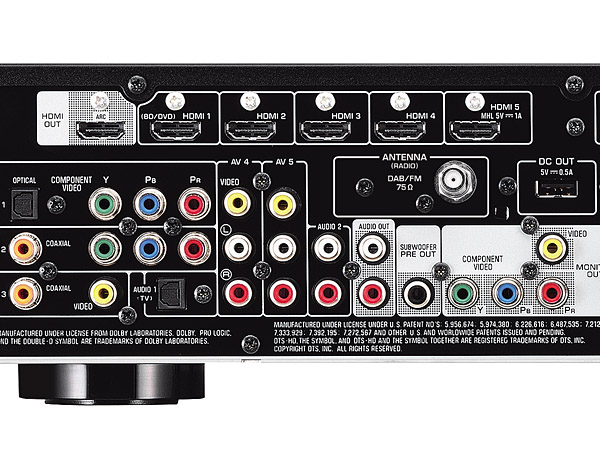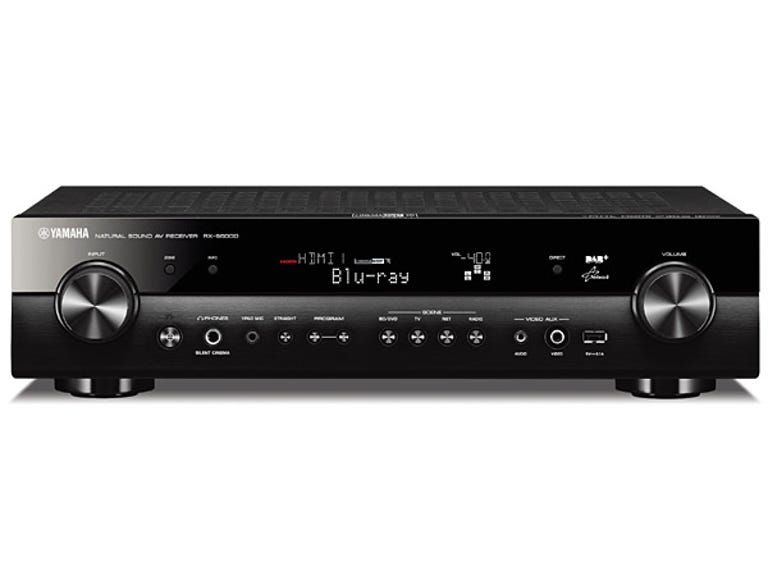 Why You Can Trust CNET
Why You Can Trust CNET Yamaha RX-S600D Home Theatre Receiver review: Yamaha RX-S600D Home Theatre Receiver
The Yamaha RX-S600D offers strong performance, proper digital radio and good network functions in a slimline package.
Yamaha's RX-S600D home theatre receiver offers two rare features. One is a built-in DAB+ radio tuner. The other is its slimline appearance. (Note: in the world of home theatre receivers, 111mm of height is pretty slimline.)
The Good
The Bad
The Bottom Line
It's a five channel unit. So many receivers these days have seven, or even nine channels, but it seems likely that the extra channels remain dormant for the most part. Few people want to load up the lounge room with seven or more loudspeakers, plus subwoofer.
The five channels are each rated at 55 watts across the full audio bandwidth, and from the specifications each could reach 80 watts at a pinch. Don't worry too much about this 55 watts compared to the 100 watts often specified for similarly priced receivers. The relationship between power and loudness is not linear. The difference between 55 watts and 100 watts is 2.6 decibels. If you pay attention you can hear a difference in volume level of one decibel, perhaps a bit less. Still, if you want lots of volume, go for efficient loudspeakers that will deliver plenty of sound for lower power inputs.
It's fitted out for HDMI, but also supports analogue video and audio and digital audio in both coaxial and optical formats. One of the five HDMI inputs supports MHL, by which some Android phones can deliver high definition video and sound while being charged.

Five HDMI inputs are available.
(Credit: Yamaha)
On the front panel is a 3.5mm audio input, which is useful whatever portable music device you use.
But you'd probably want to go digital with many devices. The USB socket on the front supports iPods and iPhones in addition to USB storage media. The Ethernet port on the back provides for audio streaming. And soon the unit will support Spotify Connect. This is a new wrinkle on the paid premium Spotify service, by which you can stream an almost limitless selection of music of your choice. You work it by playing music on your iOS device (Android's coming). When you're within range of your home WiFi network you can select the 'Connect' icon in the player, choose this receiver as the playback device, and your music starts coming from it instead.
It's a bit like Apple Airplay (which this receiver also supports) or the push version of DNLA (ditto), but in fact the music doesn't stream from your device to the receiver. Instead it connects directly through the Internet to the Spotify resource and plays it from there.
Problem is this feature depends on a firmware upgrade, which is yet to arrive. I've used Spotify on another brand successfully — with firmware that was released in recent days — and I have no reason to think that Yamaha won't fulfill its promise on this front.
You get a full function remote control. The receiver also supports Yamaha's quite interesting control apps (Android and iOS), which really come into their own when it comes to controlling its playback of network and USB media.
Setup
This receiver doesn't sport the pretty GUI of higher level Yamaha receivers, but it still offers decent functionality due to the ability of the menu to overlay whatever video is on the screen. You invoke the auto configuration by plugging the supplied microphone into the front socket and letting it run through its various noises. In addition to setting levels and distances and applying some frequency EQ, it sets the sizes of your loudspeakers. 'Small' loudspeakers have their bass redirected to the subwoofer, or perhaps to the front speakers if there is no subwoofer. You should always check this setting afterwards and change it manually if it is incorrect. As it happens, this receiver was one of the rare ones that got my speakers sizes right.
In Use
I used this receiver — carefully — with my regular home theatre speaker setup. The left and right speakers are rather low in impedance, thus the care. With movies and stereo the receiver did, well, pretty much what you'd want. It delivered good room filling levels of clean, unstressed sound. Not cinema levels, though. Or at least I wasn't courageous enough to push for that. Even with big blockbuster movies — Transformers and the like — the results were very satisfying.
On music, likewise. It sounded lovely with my regular speakers. For fun I plugged in a cheap set of stereo speakers, re-ran the calibration, and they ended up delivering quite listenable sound, thanks to their wobbly frequency response being somewhat improved by the receiver's EQ.
For higher end speakers, the receiver has a 'Direct' playback mode that eliminates most of the processing, including EQ.
The network audio functions worked well too. The receiver found my NAS drive on the network quickly and was happy to play back the high resolution stuff, including full 192kHz, 24 bit FLAC files. Stereo only, though. MP3, WMA, WAV and AAC are also supported. Likewise all these via USB.
The interface has an effective way of moving quickly through long lists. Apparently I have 540 album artists in my music collection. But faster and far more fun is to use either the Android or iOS control apps. These display album art and allow for finger flicking through long lists even more quickly than using the multiple page skip of the receiver's interface.
The DAB+ radio tuner worked well, tuning in all the available stations in a few seconds. You'll find it most convenient to go through and allocate your favourite ones to presets. The receiver doesn't feed back any information about the what's happening with the tuner on a connected display. But it does to your Android/iOS app, including any text transmitted by the station.
It's getting so that a small tablet should be a standard part of a home theatre system.
Conclusion
If you have, or want to get, really difficult loudspeakers (low impedance, low sensitivity or hard to drive in some other way), then this probably isn't the unit for you. But otherwise the Yamaha RX-S600D is a nifty, compact receiver with the rare ability to provide digital radio at no additional cost.


